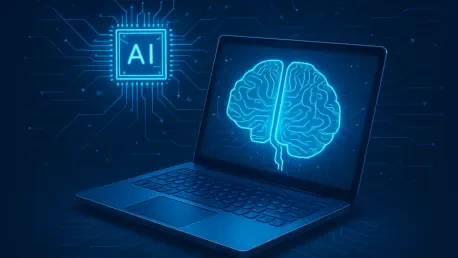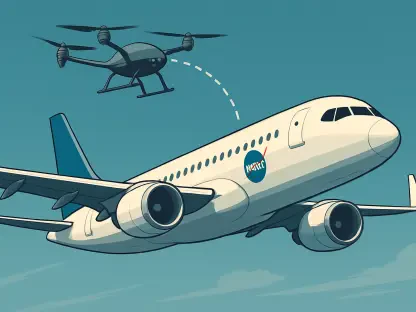The landscape of personal computing is experiencing a profound transformation with the advent of AI PCs, innovative devices equipped with dedicated Neural Processing Units (NPUs) that empower on-device artificial intelligence processing. This shift represents a significant departure from the traditional reliance on cloud-based AI systems, heralding a new era where computing becomes faster, more secure, and deeply personalized. Unlike conventional PCs tethered to internet connectivity and remote servers for complex tasks, AI PCs handle intricate AI operations locally, ensuring immediate responses and safeguarding data privacy even in offline environments.
This technological leap transcends mere hardware upgrades, fundamentally reshaping the interaction between users and their devices. By addressing persistent issues of cloud dependency—such as network delays and the vulnerability of transmitting sensitive information—AI PCs offer seamless functionality without the constant need for an internet connection. This capability broadens access to advanced AI tools, making them available to a diverse range of users who might otherwise be constrained by connectivity challenges or privacy concerns.
The ripple effects of AI PCs extend far beyond individual convenience, promising to redefine productivity across industries. From automating routine administrative duties to providing real-time language translation, these devices are set to transform daily digital experiences. Additionally, the energy efficiency of NPUs contributes to extended battery life in laptops and other portable gadgets, a critical advantage for professionals and students constantly on the move.
However, this groundbreaking shift does not come without hurdles. Significant challenges loom on the horizon, including concerns over data security with local processing, the potential for biases in AI algorithms, and the environmental toll of frequent hardware upgrades. As AI PCs gain traction, tackling these issues will be essential to ensure their benefits are equitably distributed and sustainably implemented across varied demographics and sectors.
The Core of AI PC Innovation
Hardware Breakthroughs with NPUs
At the heart of AI PCs lies a pivotal advancement in hardware: Neural Processing Units (NPUs), specialized chips engineered specifically for AI workloads. Unlike traditional Central Processing Units (CPUs) and Graphics Processing Units (GPUs), which handle a broad range of tasks, NPUs are optimized for the parallel computations integral to artificial intelligence processes. This specialization ensures that demanding AI operations do not slow down overall system performance, allowing for smoother multitasking. Furthermore, NPUs are designed with energy efficiency in mind, significantly extending battery life in mobile devices like laptops—a crucial benefit for users who rely on portability for work or study. Major industry leaders such as Intel, AMD, Qualcomm, and Apple are integrating NPUs into their latest processors, aligning with stringent performance benchmarks like Microsoft’s requirement of over 40 trillion operations per second (TOPS) to ensure robust AI capabilities.
The significance of NPUs extends beyond raw performance metrics to fundamentally alter how devices manage complex tasks, paving the way for groundbreaking advancements in computing. By offloading AI-specific computations to dedicated hardware, these units prevent bottlenecks that often occur when general-purpose processors are overstretched. This architectural innovation allows AI PCs to deliver real-time responses for applications ranging from voice recognition to image processing, all while consuming less power. The result is a more responsive and sustainable computing experience, setting a new standard for what personal devices can achieve. As chipmakers continue to refine NPU designs, the potential for even greater efficiency and capability grows, promising to push the boundaries of on-device intelligence further.
Pioneering Energy and Performance Standards
The integration of NPUs into AI PCs is not just about handling AI tasks but also about redefining energy and performance standards in computing. Traditional processors, when tasked with AI operations, often consume excessive power, leading to overheating and reduced battery life—issues that NPUs address through their tailored architecture. This efficiency is particularly transformative for lightweight devices, where maintaining long battery life without sacrificing performance is a constant challenge. The ability of NPUs to process intensive AI models locally means that users can engage with cutting-edge technology without the constant drain of cloud connectivity, marking a significant step forward in making powerful computing more practical and accessible.
Beyond energy savings, NPUs contribute to establishing new benchmarks for device performance that prioritize seamless AI integration. The industry’s adoption of standards like the 40+ TOPS threshold ensures that AI PCs are not merely incremental upgrades but represent a leap toward a future where AI is a core component of everyday computing. This focus on performance also drives innovation in heat dissipation and system design, ensuring that even the most compact devices can handle sophisticated AI tasks without compromise. As these standards evolve, they will likely shape consumer expectations, pushing manufacturers to balance power, efficiency, and AI capability in ways that redefine the personal computing landscape over the coming years.
Industry Dynamics and Competition
Race for NPU Dominance
The emergence of AI PCs has sparked an intense rivalry among technology giants and chip manufacturers, each striving to lead in NPU performance and innovation. Qualcomm has set a high bar with its Snapdragon X Elite platform, achieving an impressive 45 TOPS, while Intel and AMD are aggressively advancing their own processors across both ARM and x86 architectures to stay competitive. Microsoft’s Copilot+ PC initiative plays a central role in this race, establishing rigorous hardware standards and embedding AI features deeply into Windows 11. This push has prompted PC manufacturers like HP, Dell, and Lenovo to collaborate with chipmakers, rolling out AI PC models tailored to meet the growing enterprise demand for a significant hardware refresh cycle aimed at boosting efficiency.
This competitive landscape is further intensified by the strategic partnerships and innovations that define the industry’s direction. The collaboration between software giants and hardware producers ensures that AI PCs are not just powerful but also seamlessly integrated with operating systems for an optimal user experience. The focus on enterprise markets highlights a calculated move, as businesses prioritize productivity gains and cost reductions from decreased reliance on cloud services. However, this race also opens doors for smaller players and startups to carve out niches by developing specialized applications that leverage on-device AI, adding layers of complexity and opportunity to an already dynamic market. The ongoing competition is a catalyst for rapid advancements, ensuring that AI PC technology evolves at a breathtaking pace.
Shaping Market Trends through Strategic Initiatives
Beyond the technical race for NPU supremacy, strategic initiatives are shaping the broader market trends surrounding AI PCs. Microsoft’s leadership with the Copilot+ PC program not only sets performance benchmarks but also influences how AI is perceived as an integral part of computing. By initially favoring ARM-based Qualcomm chips and later expanding to include Intel and AMD’s x86 processors, this initiative demonstrates a flexible yet ambitious vision for AI integration. Such strategies are critical in driving adoption, particularly among corporate clients who see AI PCs as a way to future-proof their operations while minimizing dependency on external servers for data processing.
The impact of these initiatives ripples through the industry, affecting everything from supply chains to consumer expectations. PC manufacturers are aligning their product roadmaps with these emerging standards, anticipating a wave of demand as businesses upgrade their fleets. This trend is likely to accelerate as operating systems like Windows 11 continue to embed AI functionalities that require robust hardware support, creating a feedback loop of innovation and adoption. Additionally, the focus on enterprise solutions may pave the way for consumer markets to follow, especially as prices stabilize and the value of AI PCs becomes more apparent. The strategic maneuvers of industry leaders are not just about competition but about building an ecosystem where AI-driven computing becomes the norm.
Transforming User Experiences
Personalized and Real-Time Interactions
AI PCs are fundamentally changing the way users engage with technology by offering personalized, real-time interactions that were previously unimaginable without cloud support. Features such as intelligent assistants that adapt to user habits, automated administrative tasks, and advanced creative tools for photo and video editing are becoming standard. By processing AI models directly on the device, these PCs eliminate the latency associated with cloud communication, delivering instantaneous responses that enhance productivity. This immediacy, coupled with the ability to tailor experiences to individual preferences, transforms routine digital interactions into highly customized and efficient workflows.
The privacy benefits of on-device processing significantly enhance the appeal of AI PCs in user engagement, offering a secure and efficient experience. With sensitive data no longer needing to be transmitted to remote servers, users can trust that their personal information remains secure while still accessing powerful AI capabilities. Real-time language translation, for instance, can now occur seamlessly during international communications without exposing conversations to external networks. This shift not only boosts user confidence but also redefines expectations for what personal devices can achieve, setting a new benchmark for convenience and security in everyday technology use. As these features evolve, they promise to make technology feel more intuitive and responsive to human needs.
Redefining Productivity with Seamless Tools
The impact of AI PCs on productivity is profound, as they introduce seamless tools that streamline complex tasks with minimal user effort. For professionals, the ability to automate repetitive processes—such as data entry or scheduling—frees up time for more strategic work, while creatives benefit from AI-driven software that enhances editing and design capabilities with precision. These tools operate with reduced latency thanks to local processing, ensuring that workflows remain uninterrupted even in environments with poor connectivity. The result is a significant boost in efficiency, allowing users to accomplish more in less time without sacrificing quality or accuracy.
Moreover, the energy efficiency of NPUs ensures that these productivity gains do not come at the cost of device performance. Unlike traditional systems that might slow down under heavy AI workloads, AI PCs maintain smooth operation, supporting multitasking without draining battery life. This is particularly valuable for remote workers or students who rely on laptops for extended periods away from power sources. As these devices become more integrated into daily routines, they are likely to redefine professional and academic standards, encouraging a shift toward more dynamic, AI-assisted ways of working. The potential for personalized productivity tools to evolve further suggests a future where technology anticipates needs before they are even articulated.
Broader Impacts and Challenges
Edge AI and Accessibility
AI PCs are at the forefront of the edge AI movement, a transformative trend that shifts computational power from centralized cloud servers to local devices, making advanced technology more accessible to a global audience. This decentralization allows users to harness sophisticated AI capabilities without the need for extensive infrastructure or constant internet access, a significant advantage in regions with limited connectivity. By embedding smaller, efficient AI models directly into devices, AI PCs enable a wide range of applications—from smart home systems to portable business tools—thus democratizing access to innovations that were once reserved for those with robust server support or high-speed networks.
This push toward accessibility also fosters inclusivity by lowering the barriers to entry for leveraging cutting-edge technology. Small businesses, educational institutions, and individual users can now adopt AI solutions without the prohibitive costs associated with cloud subscriptions or dedicated data centers. The implications are far-reaching, potentially bridging digital divides and empowering underserved communities with tools for learning, communication, and economic growth. As edge AI continues to mature through AI PCs, it could redefine how technology serves humanity, ensuring that powerful resources are within reach of diverse populations, regardless of geographic or economic constraints.
Navigating Ethical and Practical Hurdles
Despite the transformative potential of AI PCs, several ethical and practical challenges must be addressed to ensure their responsible integration into society. Privacy remains a paramount concern, as local data processing, while reducing external risks, still requires stringent safeguards to prevent misuse or unauthorized access on the device itself. Features like Microsoft’s “Recall,” which logs user activity for AI assistance, have sparked debates over transparency and data handling, underscoring the need for clear policies and user control over personal information. Addressing these privacy issues will be critical to building trust in AI PCs as they become more pervasive.
Additionally, the risk of biases embedded in AI algorithms poses a significant ethical dilemma, as skewed data or flawed models could perpetuate unfair outcomes in applications ranging from hiring tools to personal assistants. Alongside these concerns, the environmental impact of rapid hardware refresh cycles raises questions about sustainability, with e-waste from frequent upgrades threatening ecological balance. High initial costs and the absence of a defining application to spur consumer adoption further complicate the landscape, as does the need for widespread user education to demonstrate the practical value of AI PCs over traditional systems. Overcoming these multifaceted hurdles will require coordinated efforts from industry stakeholders, policymakers, and educators to ensure that the benefits of AI PCs are realized without unintended consequences.
Balancing Innovation with Sustainability
The rapid advancement of AI PCs brings with it the pressing need to balance technological innovation with environmental sustainability, as the frequent turnover of hardware driven by the demand for ever-more-powerful NPUs and AI capabilities risks contributing to a growing e-waste problem. This issue could offset the energy efficiencies these devices offer. Manufacturers face the challenge of designing products with longer lifecycles or modular components that can be upgraded without discarding entire systems, while also exploring recycling programs to mitigate the impact of obsolete devices on landfills and natural resources.
Simultaneously, the industry must consider the broader societal implications of this innovation race, ensuring that sustainability is not sacrificed for speed to market. Collaborative efforts to establish green standards for AI PC production and disposal could set a precedent for responsible tech development, encouraging consumers to prioritize eco-friendly options. Governments and environmental organizations might also play a role by incentivizing sustainable practices through regulations or funding for green tech initiatives. As AI PCs pave the way for a new computing paradigm, embedding sustainability into their lifecycle will be essential to ensure that progress benefits both technology users and the planet in the long term.
Future Horizons for AI-Driven Computing
Market Growth and Adoption Projections
Looking toward the future, AI PCs are poised to dominate the personal computing market with remarkable speed, driven by both technological advancements and a growing societal demand for secure, efficient solutions. Industry analysts predict that these devices could account for over 50% of new PC sales within the next couple of years, with adoption rates potentially reaching 80% by 2027. This rapid growth is fueled by enterprise interest, as businesses seek to capitalize on productivity enhancements and reduced reliance on cloud services, setting a precedent that consumer markets are likely to follow as costs decrease and awareness spreads.
The trajectory of this market expansion also hinges on critical milestones, such as the end-of-life for older operating systems, which will push organizations to upgrade to AI-compatible hardware. Strategic initiatives from tech leaders to integrate AI at the operating system level further accelerate this shift, ensuring that new devices are not just optional but necessary for accessing the latest software features. As AI PCs transition from niche to norm, their influence will extend into diverse sectors, from education to healthcare, reshaping how technology supports human endeavors. This projected growth underscores the transformative potential of on-device intelligence to redefine computing standards globally.
Envisioning the Next Era of Integration
As AI PCs continue to evolve, the next era of integration promises to blend local and cloud processing into hybrid environments that optimize both performance and privacy. This approach could address current limitations by leveraging the strengths of on-device intelligence for immediate tasks while tapping into cloud resources for more complex computations, creating a balanced ecosystem. Innovations such as “Personal Foundation Models,” tailored to individual user behaviors, might emerge, offering proactive assistance that anticipates needs with unprecedented accuracy, further personalizing the computing experience.
Beyond hybrid models, the horizon holds potential for integrating cutting-edge technologies like quantum or neuromorphic computing into AI PCs, pushing the boundaries of what these devices can achieve. Such advancements could unlock new applications, from ultra-fast data analysis to enhanced cybersecurity measures, positioning AI PCs at the forefront of technological progress. However, realizing this vision will require overcoming persistent challenges, including skill gaps among users and the high cost of advanced hardware. As industry efforts focus on refining NPU performance and fostering standout applications, the path forward will likely solidify AI PCs as indispensable tools, shaping a future where intelligent computing is seamlessly woven into every aspect of life.
Reflecting on a Transformative Shift
Reflecting on the journey of AI PCs, it’s evident that their arrival marked a defining milestone in the history of personal computing. These devices shifted the paradigm from cloud-centric AI to localized, on-device intelligence, leveraging Neural Processing Units to deliver unmatched efficiency and privacy. Tech giants like Microsoft, Intel, AMD, and Qualcomm drove relentless innovation, while enterprise adoption catalyzed a wave of market refresh that reshaped industry priorities. The rise of edge AI through these PCs democratized access to advanced tools, enhancing productivity and redefining digital interactions across countless fields.
As challenges around security, algorithmic bias, and environmental impact were navigated, the industry took critical steps to address them, setting the stage for sustainable progress. The integration of AI at deeper system levels, exemplified by initiatives like Copilot+ PC, underscored a collective vision for a future where technology anticipated human needs. Looking back, AI PCs proved to be more than a trend—they became a foundational shift that influenced how society engaged with technology. Moving forward, the focus remains on refining hardware, blending processing models for optimal balance, and identifying compelling applications to ensure broader adoption, ensuring that this transformative era continues to evolve with purpose and responsibility.









